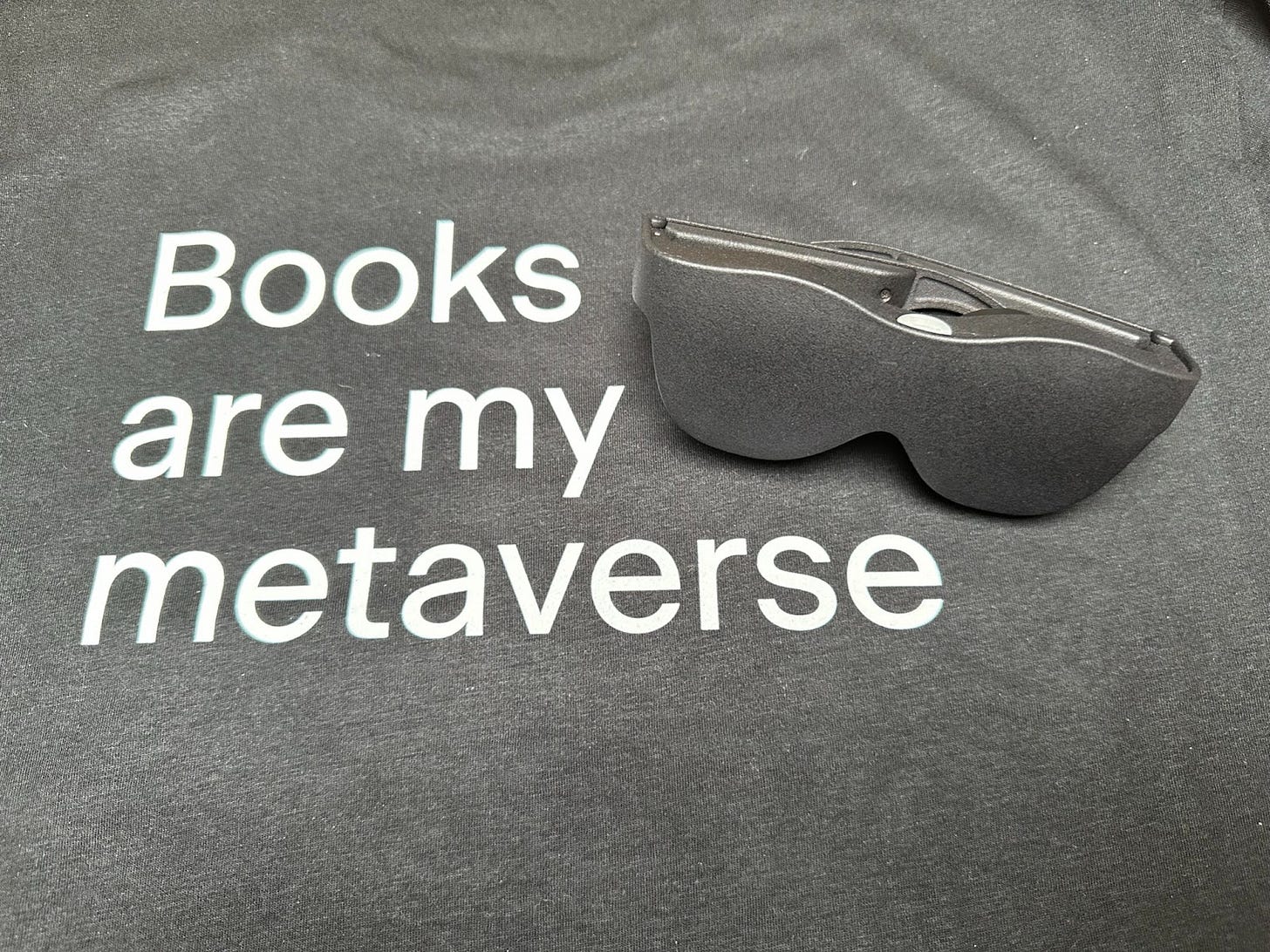Why Books are My Metaverse: Part I
Because the Short-Term Goal Posts for AR/VR Aren’t in the Right Place
This is a multi-part series that shares my experience in building the Sol Reader.
“Books are my metaverse” means a lot more than the simple pun of building a smart-glasses product focused on reading. In a few short missives, I’ll tease this out by diving into the “why” behind the Sol Reader – a new wearable e-reader. We touch on the state of AR/VR/MR, The Jetsons, smartphones and what they do to our brains, the joy of reading, and more!
Are books your metaverse, too? Join our waitlist or shoot me a note at ben@solreader.com.
AR/VR/MR is the long-standing “next big leap in personal computing.” But this next big thing hasn’t manifested despite lots of ambitious attempts (Oculus, Google Glass, HoloLens, MagicLeap, the list goes on and on). Admittedly, I’ve been perennially skeptical of the AR/VR/MR world. The widespread optimism of companies behind these technologies promise great futures that never really match the lived experience. Let’s quickly review.
The VR promise is beautiful rendering of completely immersive 3D worlds. The reality is that computationally, this is still really hard while keeping battery life and weight in check. And optically, the display and lens technology isn’t there to remove unnatural-looking artifacts (I’m looking at you, Mr. Screen Door).
The AR promise is an always-on-your-face-just-like-a-pair-of-Ray-Bans experience. The reality is that we’re still tethered, or it’s super heavy, or you have to charge every couple hours, or you only get audio, or it’s monocular, or or or.
The promise is a second life, or maybe a hands-free smartphone. The reality is the unsettling question: do we even really want that?
Our goalposts for AR/VR/MR in the short term are in the wrong place. If we spend less time thinking about Virtual Reality, Augmented Reality, and Mixed Reality, and more time thinking about Actual Reality, we’ll end up on a better trajectory for FaceTech (yeah, I’m just going to call it that from now on). A focus on Actual Reality leads us to dream about achievable, clear-value-add, well-scoped use cases that deliver on the promise.
Remember, it took us 40+ years to go from this…
to this.
So let’s take a step back and scope the problem a little differently to see what emerges.
Early in 2021, one of my co-founders pitched me the idea of building FaceTech for reading and, admittedly, I was dismissive at first. That is, until I started prototyping it.
I’m no Palmer Luckey, so I fumbled through many iterations, but one thing was consistently true: reading hands-free in bed was pretty great. And at the very least, this path was better than anything I could find on the internet:



My FaceTech skepticism diminished when I found a solution that opened up compelling possibilities to me as a user plus was technically more feasible to meet the promise of magical-feeling FaceTech (independent, non-tethered, long battery life, light-weight). So I pulled on the thread more and more each month.
We picked some new constraints for FaceTech and this specific application with wonderful results:
Rendering a page of text is simpler than 3D worlds with requisite eye tracking, so the hardware and software are simplified.
E-paper instead of LEDs and LCDs. It performs very differently under magnification with, specifically, no Screen Door Effect.
Throwing out true VR (no need to be 360 degrees), we get peripheral vision while wearing, which eliminates the uneasy “am I gonna smack my head / hand” feeling in VR.
Throwing out true AR (we occlude vision and aren’t transparent), we get a simpler optical design.
And all of this adds up to overall less complexity computationally and optically. The result is FaceTech that’s light-weight, long-battery life, non-tethered, and pretty much perfect for reading.
Here’s a table that compares our new FaceTech (the Sol Reader) with the Quest Pro and the nReal Air and, for comparison, Joe Biden’s Aviators:
Sure, we aren’t quite to Biden’s Aviators level of performance, but that’s the eventual standard for a palatable mass-market FaceTech device. And while you can’t watch a movie or wander around legless in the Metaverse, you can do one thing that most people wish they did more of every day, and that’s read.
By redefining the goal posts, we’ve found a wonderfully elegant way to lead the way to a more general purpose FaceTech world, and along the way we’ve discovered that we may never even want to go there. But that’s a topic for another time! The Sol Reader is one of many devices we’ll see emerge in the next decade in the FaceTech space. Our hope is that for other innovators and entrepreneurs, they’ll set their sights on the right next steps for this industry so we all get to enjoy a better Actual Reality.
Are books your metaverse, too? Join our waitlist or shoot me a note at ben@solreader.com.








Your thesis and points really ring true. I’m truly looking forward to trying the Sol Reader
Ordered. Can't wait to try. Makes me think of the magical, escapist moments I had reading books as a kid - I haven't experienced that in a book since.